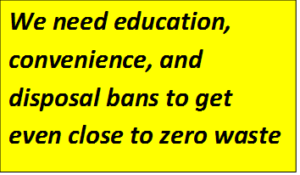Every Tuesday night I come face-to-face with the twin issues of consumption and “sustainable materials management” or the latest buzzword favoured by governments, the “circular economy.” For Tuesday night is Recycling Night.
From the bathroom and bedroom, I gather toilet rolls and tissue, envelopes and writing paper. From the kitchen and dining room, I grab the box of recyclables holding newspapers, cartons, cans, jars, and bottles; the special food scraps bag (made of compostable paper, of course) that’s stored under the sink; and the small “garbage” bag of other stuff. Then I head for the big carts parked in the garage before wheeling the appropriate ones (this week, recycling and organics) out to the curb for the morning pick-up. All told, it takes me maybe five or ten minutes. And I feel good about it, doing my little bit for the circular economy.
What I have learned from this exercise is that education and convenience are key. It is very true, as someone has said, that waste diversion is all about a flick of the wrist, that crucial moment when the householder decides whether something goes into the recycling or into the garbage. If garbage is easier, that’s where it goes, and generally, that’s where it stays.
I have a special interest in enhancing the recovery of paper, and Ontario’s Blue Box system is doing very well in this regard with almost three-quarters of it being sent on for recycling. But far too much paper is still slipping through the cracks: mainly old boxboard (such as cereal and shoe boxes) and printing and writing paper.
If most (say 85%) of that perfectly recyclable but dumped paper were instead captured and sent for recycling, provincial Blue Box paper recovery would jump to an amazing 96%, and the Ontario Blue Box overall from its current 64% to a very impressive 78 per cent. Folks, this is actually achievable, if only we set our minds to it!
It’s not as if there are no steady markets for the various paper materials. There are. In fact, the packaging mills of Southern Ontario led North America in pioneering the recovery of old boxboard back in the 1990s. We have gone from boxboard not being collected at all to virtually all Canadians (94%) being able to recycle it in the space of 20 years. An impressive achievement.
No, the issue is not markets, as some government people will tell you, it is capture. We are not physically getting enough paper material out of the home because it’s too easy for householders to

flick the wrist. So how do we get them to flick in the right direction?
Education is key. We drool over British Columbia’s new Blue Box program where there is a standard list of materials accepted province-wide. Imagine that! One consistent recycling message across the whole province. Wouldn’t that be great! Remove the confusion. Save money on promotion. Increase the capture rate.
But we also need to engineer the Blue Box system for greater convenience. Municipalities and their service providers have been very creative in this respect: encouraging recycling by charging for garbage bags or bins and by limiting the number of garbage bags allowed at the curb and/or the frequency of garbage pick-up. Restrict the “garbage opportunity” and encourage recycling. Great stuff. And we do recognize that multi-residential apartments represent a special problem. It’s a lot easier to dump something down a garbage chute than to separate the recyclables and carry them in the elevator to a downstairs recycling bin.
But somehow we have to educate Canadians that most paper materials are perfectly recyclable; that there are long-standing and sustainable markets for them; that most boxes and cartons made in Canada, for example, are already 100% recycled content, and that the industry needs this household paper as feedstock to make new packaging; that this ongoing recycling activity provides local jobs and taxes; and that paper recovery is a great example of the circular economy and the goal of zero waste that we all hopefully aspire to, and is in our collective best interests.
Provincial governments have a key role to play too, in getting more paper out of the waste stream. For years, governments have been telling the packaging industry to reduce, re-use, and recycle. And it’s been doing that. But guess what, the provinces can do something too, something that industry can’t. They can introduce disposal bans on materials headed to landfill.
How about it? It’s not as if it hasn’t been done before. Nova Scotia and PEI have had disposal bans on paper materials for years. Wouldn’t a disposal ban send a great message to everyone that paper doesn’t belong in landfill; that it’s a valuable feedstock; that banning it from the dump would reduce the greenhouse gases released to the atmosphere and mitigate climate change? Isn’t that what we’re all supposed to be doing?
The English novelist Charles Dickens once described politics as the art of scurrying nowhere in a violent hurry. We wish some governments (OK, Ontario in particular) would scurry somewhere fast (hint: disposal bans) in more of a hurry! At the moment the province is not even considering disposal bans on paper until “2019 and beyond.” Which just happens to be safely past the next scheduled elections. Shame on them! Hurry hard!
Household paper that shouldn\’t be in the garbage
(the 26% that doesn\’t make it to the Blue Box)


The English novelist Charles Dickens once described politics as the art of scurrying nowhere in a violent hurry. Love it John, now just add the impact on carbon to make it current. 🙂